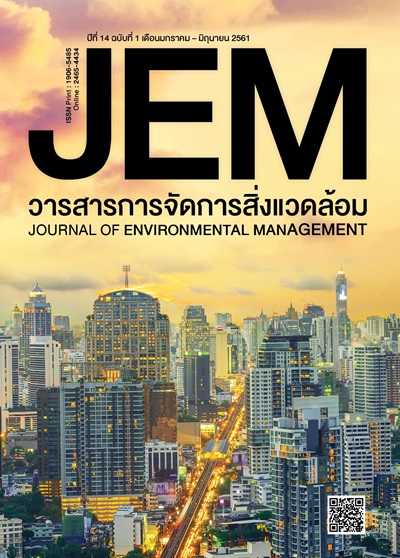ความเต็มใจจ่ายของผู้ขับขี่เพื่อลดการปล่อยก๊าช CO2 ของน้ำมันแก๊สโซฮอล์ DRIVERS’ WILLINGNESS TO PAY FOR CO2 EMISSION REDUCTION OF GASOHOL E20
คำสำคัญ:
ลดการปล่อยก๊าซ CO2, น้ำมันแก๊สโซฮอล์, แบบจำลองทางเลือก, ความเต็มใจจ่าย, แบบจำลอง Mixed logitบทคัดย่อ
การศึกษาครั้งนี้มีวัตถุประสงค์เพื่อศึกษาคุณลักษณะของระดับการลดก๊าซคาร์บอนไดออกไซด์ ของน้ำมันแก๊สโซฮอล์ E20 ที่มีผลต่อการตัดสินใจเลือกใช้น้ำมันและความเต็มใจจ่ายของผู้ขับขี่ที่มีต่อคุณลักษณะระดับการลดก๊าซคาร์บอนไดออกไซด์และคุณลักษณะอื่นๆ อาทิ วัตถุดิบของเอทานอล และระยะทางที่รถวิ่งได้ โดยทำการเก็บตัวอย่างผู้ขับขี่ที่เลือกเติมน้ำมันแก๊สโซฮอล์จำนวน 300 ราย ในเขตกรุงเทพมหานคร และทำการวิเคราะห์ผลการศึกษาโดยใช้แบบจำลองทางเลือก (Choice Experiment) และการประมาณแบบจำลองด้วยวิธีโลจิตแบบผสม (Mixed logit) ผลการศึกษาพบว่า ผู้ขับขี่ส่วนใหญ่ได้รับข้อมูลและมีความเข้าใจเกี่ยวกับน้ำมันแก๊สโซฮอล์ E20 ในระดับปานกลางแต่มีทัศนคติที่ดีในระดับมากถึงมากที่สุด โดยการเลือกใช้น้ำมันนั้นผู้ขับขี่ให้ความสำคัญกับราคามากที่สุด รองลงมาคือ ระยะทางการวิ่ง ประเภทของน้ำมัน และระดับการลดก๊าซคาร์บอนไดออกไซด์ตามลำดับ ส่วนคุณลักษณะที่เพิ่มความน่าจะเป็นในการตัดสินใจของผู้ขับขี่อย่างมีนัยสำคัญทางสถิติ คือ ราคาน้ำมันแก๊สโซฮอล์ และระยะทางที่รถวิ่งได้ โดยผู้ขับขี่เต็มใจจ่าย 1.1144 บาทต่อกิโลเมตรต่อลิตร เพื่อเพิ่มระยะทางการวิ่ง ในขณะที่การลดระดับการปล่อยก๊าซคาร์บอนไดออกไซด์เป็นคุณลักษณะที่ไม่มีนัยสำคัญทางสถิติ
เอกสารอ้างอิง
Methods. NOAA-National Oceanic Athmospheric Administration, Washington, USA.
Bank of Thailand. (2017). Ethanol Price Situation 1/2017 [in Thai]. Retrieved Aug 15, 2017, from
https://www.bot.or.th.
Bateman, I. J., Carson, R. T., Day, B., Hanemann, M., Hanley, N., Hett, T., ... Swanson, J. (2002).
Economic Valuation with Stated Preference Techniques. United Kingdom: Edward
Elgar Publishing Limited.
Bhandari, A.K., & Heshmati, A., (2010). Willingness to pay for biodiversity conservation. J. Travel Tour.
Mark. 27, 612-623.
Champ, P. A., Boyle, K. J., & Brown, T. C. (2003). A Primer on Nonmarket Valuation. The Economics
of Non-Market Goods and Resources. MA: Kluwer Academic Publishers, Boston
Department of alternative energy development and efficiency. (2015) . Alternative energy development
plan: AEDP 2015 [in Thai]. Retrieved Sep 27, 2016, from https://www.dede.go.th.
Ezebilo, E.E., & Animasaun, E.D. (2011). Economic valuation of private sector waste management
services. J. Sustain. Dev, 4, 38-46.
Fimereli E. & Mourato. S. (2009). CONSUMER PREFERENCES FOR BIOETHANOL BLENDS. Paper
presented at the 2009 EAERE Summer School, 5th-11th July 2009, Venice
Hanley, N., Mourato, S., & Wright, R. E. (2001). Choice modelling approaches: a superior alternative
for environmental valuation?, 15(3), 435-462.
Hansantiae, W. (2008). Media exposure and factors affecting the use of gasohol E20 of drivers in
Bangkok [in Thai], Bangkok: Chulalongkorn University.
Kimberly, J., Christopher D., Burton C., Jamey, M., Denise, K., & Adrienne C. (2010). Willingness
to pay for E85 from corn, switchgrass, and wood residues. Department of Agricultural
Economics, The University of Tennessee, United States.
Lo, A.Y., & Jim, C.Y., (2010). Willingness of residents to pay and motives for conservation of urban
green spaces in the compact city of Hong Kong. Urban For. Urban Green, 9, 113-120.
McFadden, D. (1974). Conditional logit analysis of qualitative choice behavior, in Zarembka
P (ed.), Frontiers in Econometrics, 1974, 105-142.
Nilrit, S., Sampanpanish, P. & Bualert, S., (2017). Comparison of CO2 Emissions from Typical
Passenger Vehicles in Thailand. Applied Environmental Research, 39(1), 65-74.
Prasarnkate, T. (2012). Factors Affecting Private Car Users’ Adoption of Gasohol E85 Usage at
a Gas Station, J. of Soc Sci & Hum. 38(2): 223-235.
Premashthira, A. (2017) Exploring behavior and factor affecting driver preferences for gasohol,
The proceeding of 55 th KU annual conference [in Thai], 55, 185-193.
Sanjoy B., Petrolia, D., & Herndon, C. (2008). Estimationg Willingness to Pay for E10 fuel: a
contingent valuation method. Southern Agricultural Economics, Mississippi State
University, Dallas, Texas.
Thongchoung, S. (2008). The Quantity Analysis of Gasohol E20 Consumption in Thailand [in Thai],
Bangkok: Bangkok University.
Yang, J., L. Zou, Lin, T.,Wu, Y., & Wang, H. (2014). Public willingness to pay for CO2 mitigation and
the determinants under climate change: A case study of Suzhou, China. Journal of
Environmental Management, 146(Supplement C): 1-8.



